Winter in Melbourne is the time to attend to your fruit trees. It is important to invest time and effort into fruit trees during winter, to ensure that you have successful fruit crops in summer. Some fruit tree related tasks that are traditionally completed in winter are:
- Winter pruning of fruit trees
- Planting bare rooted fruit trees.
- Setting up and maintaining espaliers
- Controlling citrus gall wasp
- Controlling curly leaf
Want some hands on experience?
Why not book in for a Fruit Tree Pruning Masterclass in your own backyard?
Winter pruning of fruit trees
Neglecting to prune your fruit trees won’t stop production of fruit. However, I recommend you prune annually, to improve the quality of fruit, and to establish a strong framework of branches to support heavy fruit loads. Winter pruning is used to train a tree to a particular shape, or to encourage substantial growth. Winter pruning is recommended for newly planted trees until the tree has achieved the desired height and shape.
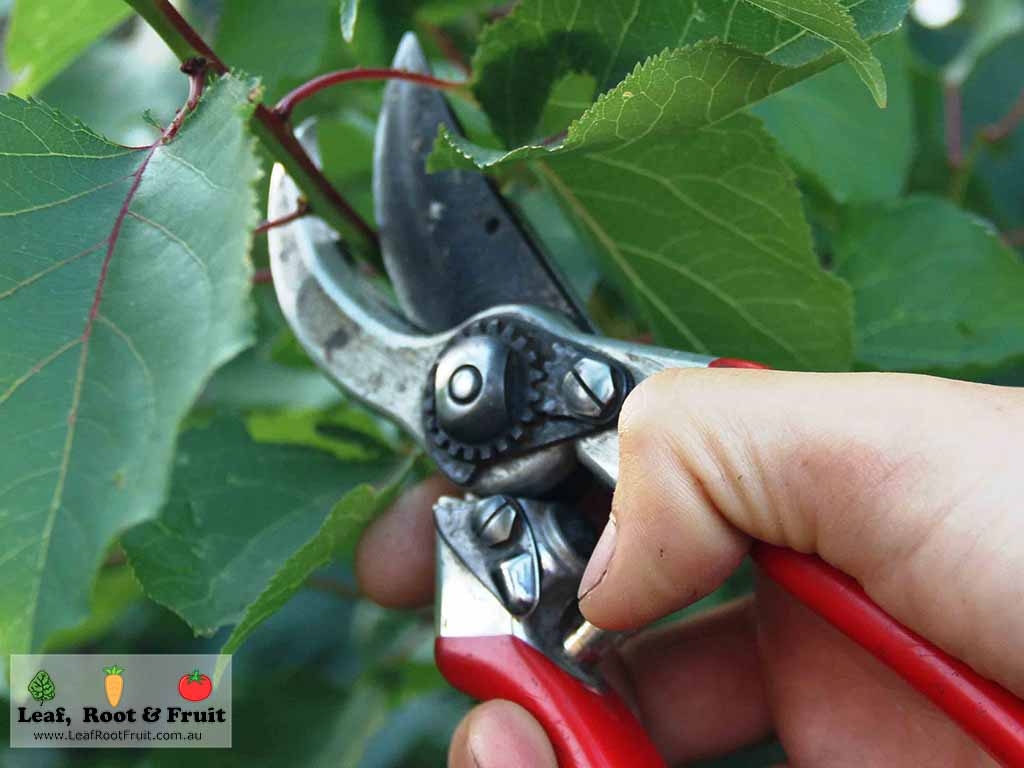
Ideally, established fruit trees are pruned in late summer. If your established tree missed out on its annual summer prune this year, then it may benefit from a prune during this winter.
I have an extensive blog post on fruit tree pruning, including all the tools you’ll need and how to go about it.
Planting Bare Rooted Fruit Trees
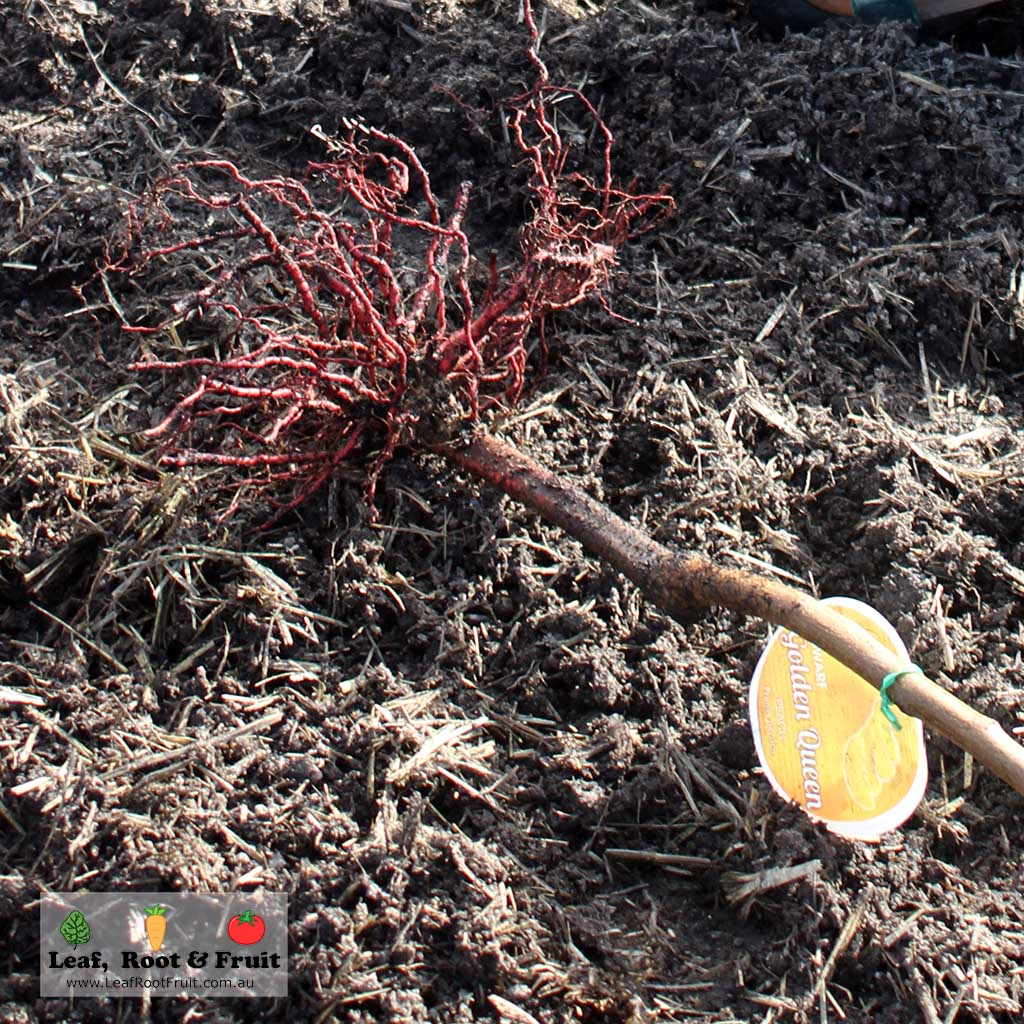
Fruit trees are dormant in winter. That means that it is the ideal time to plant out bare-rooted fruit trees. Bare rooted fruit trees have been grown in large propagating beds. The plants are lifted when they are dormant and all the soil is washed off the root system. The plants are then often kept in sawdust until they are sold. The savings in not using potting mix, a pot and reduced labour costs are passed onto the consumer in the form of cheaper fruit trees.
You’ll find them for sale at your local nursery. Before you buy any new fruit trees, it’s important that you understand the importance of buying fruit trees grafted onto the appropriate rootstock. As a general rule, I advise against buying fruit trees from the large hardware chains. They’re usually on rootstocks that are less than ideal and will mean that you’ll become a slave to their rampant growth habits. I can’t express how important it is to buy your fruit trees on the appropriate rootstocks.
Consider the timing of ripening for specific fruit varieties when planning a backyard orchard. Plant varieties that fruit at different times to each other to extend your harvest. Avoid buying varieties that will ripen when you are not there to pick them. For example, avoid January ripening varieties for school kitchen gardens. I’ve put together a detailed guide to variety ripening times to help you plan your own backyard orchards and to minimise gluts.
Some great suppliers of fruit trees, that I recommend are:
- Twin Hives Nursery (Monbulk, Vic)
- Ceres Nursery (Brunswick)
- Daleys Fruit Tree Nursery (Online, NSW)
- Yalca Fruit Trees (Online, Nathalia, Vic)
- Woodbridge Fruit Trees (Online, Tasmania)
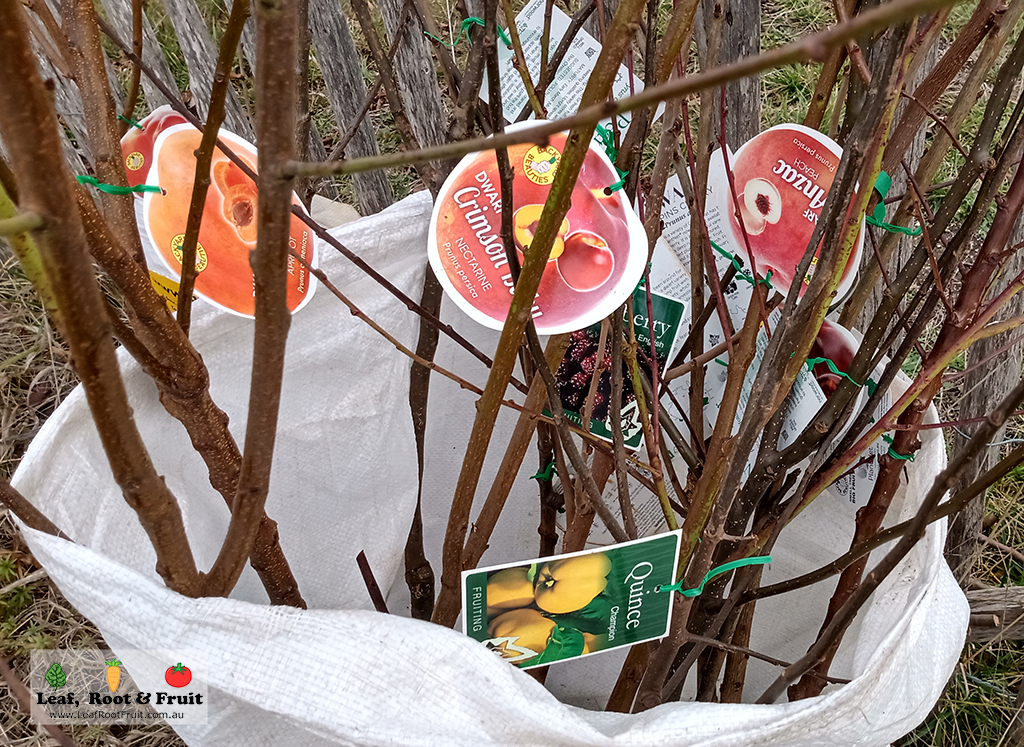
Other than rootstock selection, the second most important aspect of planting your bare rooted fruit tree is the hole in which you plant it.
If you pour water into the hole and it takes longer than 15 minutes to drain away, then the drainage needs improving. This is particularly important for citrus trees. In heavy, clay soils, consider planting the tree on top of the soil and building soil up around it.
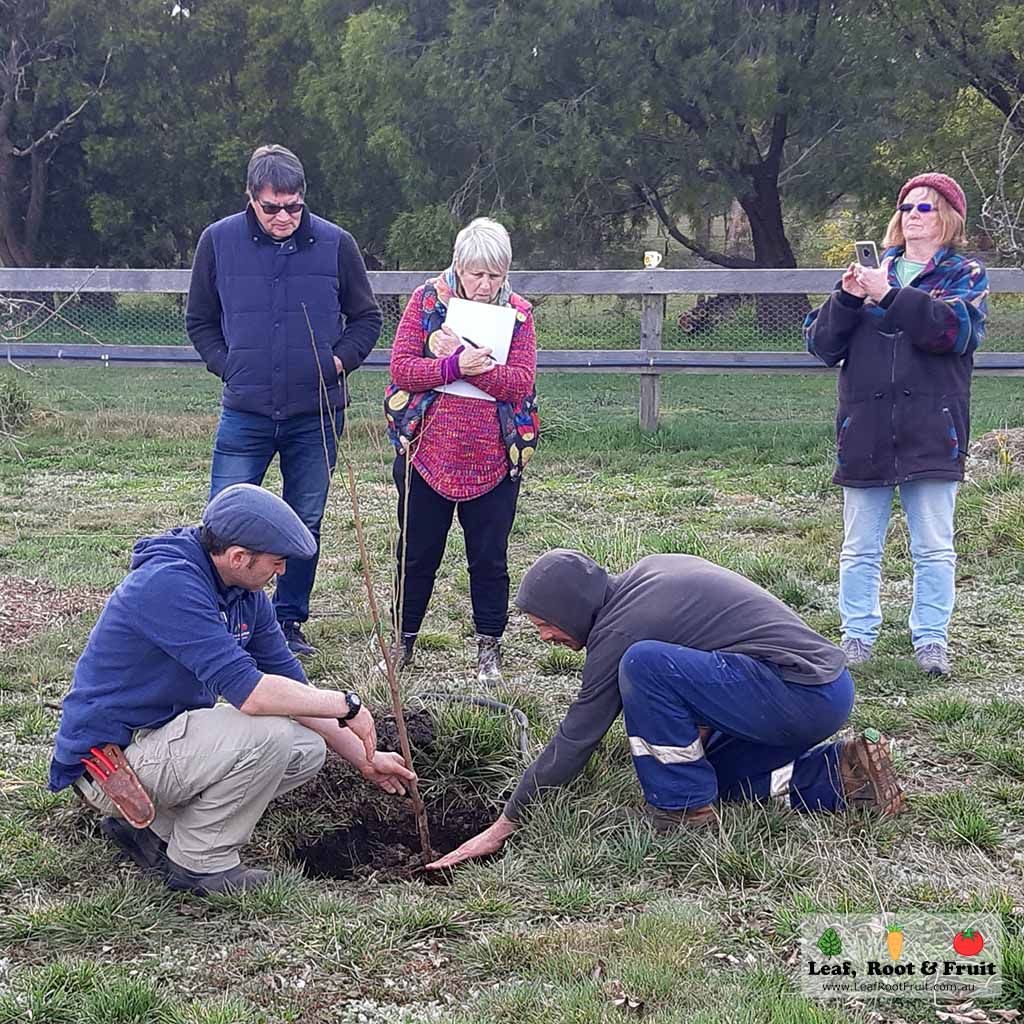
Plant the tree to the same soil depth that it was originally growing at and water in well. You will need to trim the tree back to compensate for the damage that the root system received when being dug out of the ground at the tree farm.
Mulch the trees with straw to prevent water loss. This mulch will also help prevent weeds and grass from increasing humidity around the trunk of the tree which could lead to fungal diseases.
If you’re unsure of what sort of fruit trees to plant, or where or how to plant them, I offer many great workshops on backyard orchards. Check out my upcoming events to see when the next one is running.
Fruit Tree Espaliers
Don’t think that you have enough room to grow a fruit tree? Why not try an espalier or two?
“Espalier” refers to special practices for training fruiting trees onto trellises. Espaliers save space and are beautiful works of art. There are many styles and designs of espalier that can be grown against a wall, a building or on an existing fence or wires. Espalier can also be used as a screen in the garden, to create rooms or to hide unsightly areas.
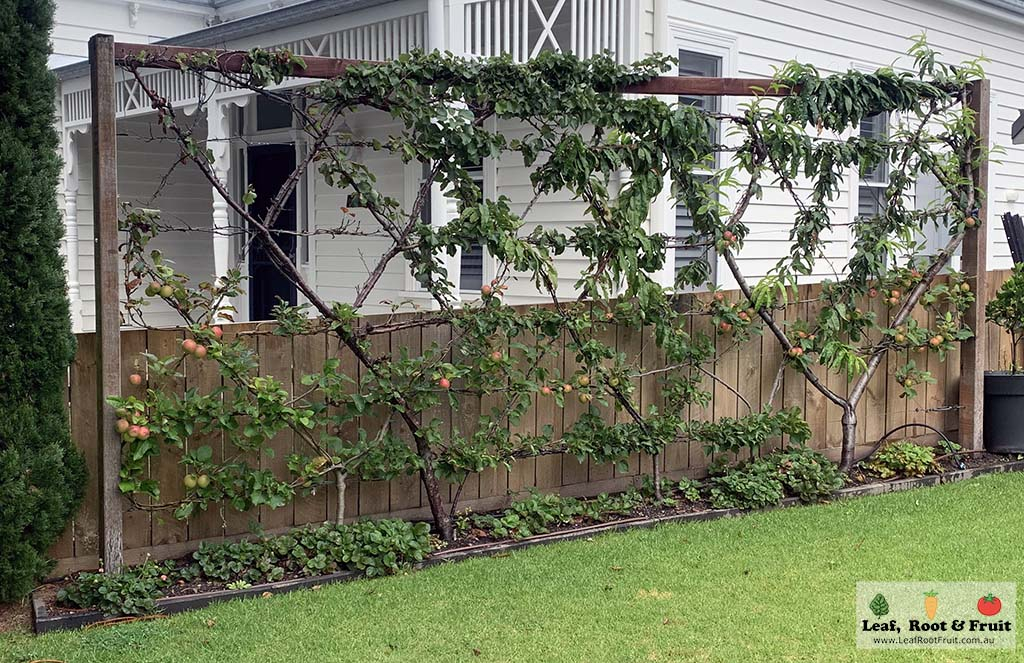
Espaliers can use space along the drive that would be too small for a full tree. They provide interest in all seasons: stunning form in winter, flowers in spring, fruit in summer and autumn’s foliage. Most importantly, they provide healthy, home-grown fruit for your family.
Winter is a great time for planting, setting-up, pruning and maintaining espaliers. Established, potted, espalier trees are very expensive to buy. What’s more, they are often grown on the wrong rootstocks. This means that they’ll be a lot of work to maintain their established espalier shape.
For more information please see my comprehensive guide on setting up and maintaining fruit tree espaliers.
Citrus Gall Wasp Control
The presence of large swellings or bulges on the branches of citrus trees is quite common in Melbourne. These swellings indicate that Citrus Gall Wasp has infected the tree.
This tiny native Australian wasp lives for 3 to 4 days and lays its eggs in the branches of the citrus tree. It is the tree’s ‘reaction’ to this egg-laying which produces the next year’s Gall Wasp.
The traditional method used to control of Citrus Gall Wasp is cutting off the swollen branches. I don’t advocate for using this method. See my blog post on citrus gall wasp for my alternative views on this pesky Melbourne citrus pest.
Prevention of Curly Leaf in Peaches and Nectarines
Do you have stone fruit trees, such as peaches, nectarines or apricots? If so, it’s traditionally the time to treat them in winter for leaf curl.
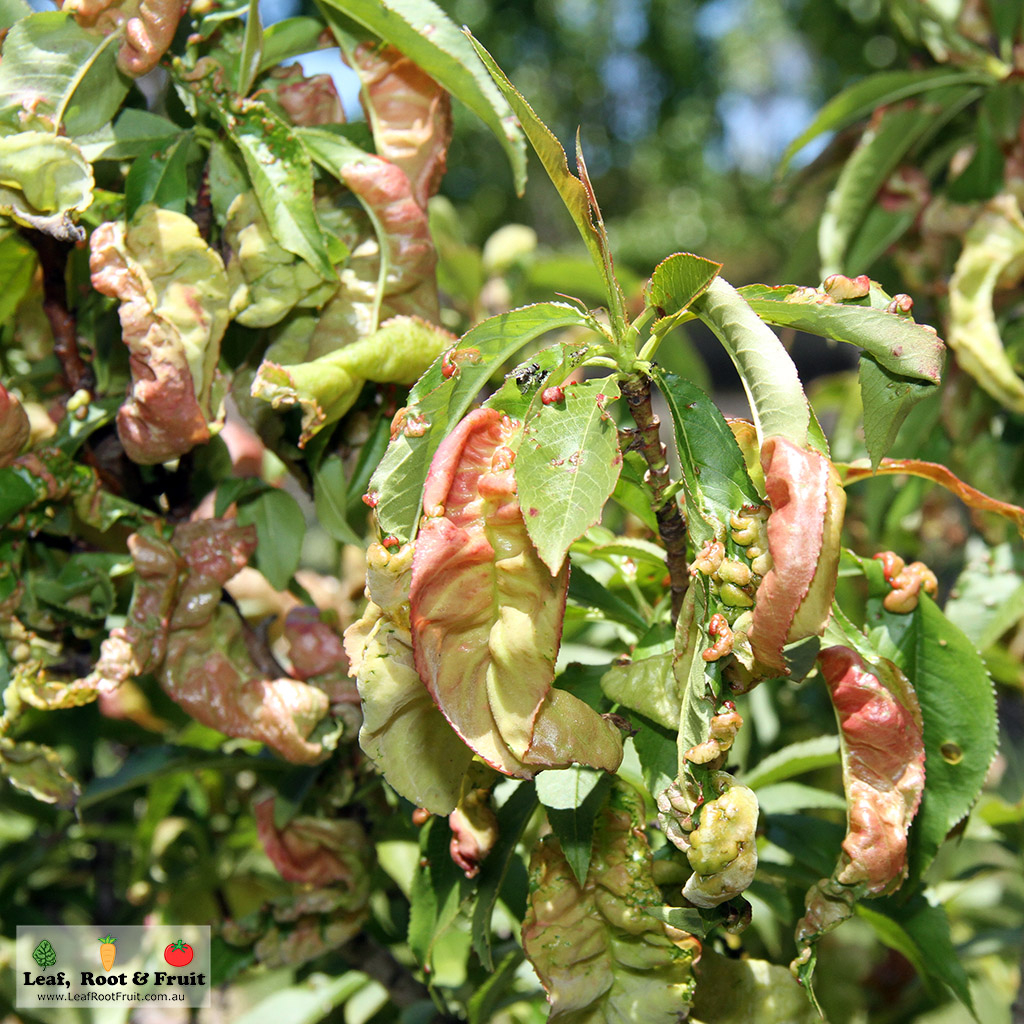
Leaf curl is a fungus that loves cold and wet conditions and infects peach and nectarine trees. As the fruit tree buds swell, the fungus gets to work infecting the leaf cells. This stimulates the leaves to grow larger than normal and often with a reddish tinge. Usually infected leaves fall from the tree, leaving it weakened and less able to produce fruit.
Traditionally gardeners try to prevent curly leaf with one or two well-timed applications of a fungicide spray such as copper sulphate or Bordeaux spray. There are many commercially available fungicide sprays available at your local nursery or hardware store. If you’d like to have a go at making your own, try this recipe for Bordeaux spray
Spray the trees with your chosen fungicide in winter, while they are still dormant and just as the buds begin to swell. Consider a follow-up spray again when the flowers open. You need to spray enough to cover all the bare branches of the tree so that it’s dripping.
Leaf curl treatments burn leaves, which is why they must be applied during winter dormancy before flower buds or leaves open.
I advocate for not spraying trees for leaf curl as I don’t believe that it makes much of a difference to the outcome.
Sign up to my newsletter for a monthly edible gardening wrap-up, including:
- A guide on what to plant in your garden in the upcoming month
- What’s happening in my garden and other gardens across Melbourne
- Upcoming gardening events
- Hints and tips on gardening


Hi I was given a dwarf nectarine tree for Christmas last year. I have it in a large pot. After loosing all its leaves it is now flowering and getting buds. What do I need to do to it now that Spring is here??? I live in Melbourne.
Hoping you can help me care for my baby!!!!!
cheers Marg
Hi Marg,
you don’t need to do much in terms of care for your tree in spring. Just make sure that it is regularly watered. If it is particularly laden with fruit then you might want to thin it in a month or so. Ultimately you want to end up with one fruit on every 10cm branch. If you haven’t already done so, why not sign up to our newsletter? That way you’ll receive plenty of seasonal hints and tips each month.
Good Luck and Happy Gardening!
Duncan
I cannot understand the punning part, you note that it has to be done annually, but both in summer and winter. Can you please elaborate?
Hi Anna,
Sorry for the confusion. You can prune your tree at most time of the year. Even multiple times of the year!
Winter pruning is generally done for the first few years of the tree’s life. This is to promote vigorous vegetative growth and establish the framework. Once the tree has an established framework, you want to switch to summer pruning. This promotes fruit rather than excessive vegetation.
That being said…. with many of the dwarfing rootstocks these days, you don’t need to do much pruning at all (if any). A tree that is left unpruned will generally be more resilient, disease free, longer lasting and more productive in the long run. The only problem is that not many nurseries stock fruit trees grafted on to suitable rootstocks for us to forget about pruning. We have listed a few different nurseries that we recommend within the article above.
Hope this clears everything up for you. If you’d like me to go through this in person, in more detail then I’m happy to organise one of our site visits.
Kind Regards
Duncan
Hi Duncan,
I have a Nellie Kelly passionfruit that I planted 18months ago. It faces North, I fed it per the book, it is now 10.5M wide and 2.7M tall and produced 583 passionfruit this year!!! How much should I prune this monster and when should I do it? I am concerned as to how big it will grow and what to do.
Regards Mike
Hi Mike,
What a productive monster you’ve grown. We get a lot of queries from people whose passionfruit keep dying, so it’s nice to have someone asking advice about the opposite for a change! Passionfruit vines don’t need any pruning for fruit production etc. However, they can be cut back to a manageable size. This is best done in spring when the plants begin to start actively growing again. However, you can prune them at any time of the year with little impact.
Good Luck and Happy Gardening!
Duncan
Good tip on citrus wasps! Thanks?
Glad you found it useful Owen.
good Luck and Happy Gardening!
Duncan
Thanks for advise on citrus wasp will try.
Hi, I am a beginner in gardening space and wanting to plant some fruit trees (peaches or nectarines) in my front garden. What is the best time to plant them, i want manageable size trees so is it better to go with grafted plant potted trees rather than the bare root ones?
How soon can i expect fruits , and what is the best approach given one is short on time (full time working mum of two) 🙂
Hi Shilpa,
Thanks for your questions. The tree size is conferred by the type of rootstock used, not whether the plant is sold as a bare rooted or potted plant. I’d recommend waiting until July/August to plant your fruit trees and use trees on a dwarfing rootstock. Not all dwarf rootstocks are the same, so you’ll need to source the correct ones for the size of tree that you want and your soil conditions.
Some of the trees on dwarf rootstocks will fruit the year you plant them, others will take a year or so. Full sized trees can take many more years to produce fruit. It all depends on the size and age of the tree when you purchase it and the type of rootstock that it is on. For more information on rootstocks please see this article on our webpage: https://www.leafrootfruit.com.au/how-to-grow/choosing-the-right-fruit-tree-rootstock/
I’d need to see the site and discuss your needs further before recommending which rootstocks and varieties are best for you to plant. It might be worth getting me out for a site consult and we can give you further information on how to prepare the soil, where to purchase trees etc. We can also give you a quote for doing it all for you!
Good Luck and Happy Gardening
Duncan
HI there, I’m planting a dwarf apple tree this weekend. Is it a good idea to test the ph of the soil? (someone suggested that) I plan to do this and change soil if necessary. I don’t have a compost just yet to add before planting.
Thanks Angela
Hi Angela,
We don’t normally test for pH of soil. That being said, we have a fairly good idea of the soil profiles around Melbourne. It is unlikely that in Melbourne’s soils you will need to alter the pH much anyway. The only exception may be for berries such as blueberries, but not for apples.
Addition of compost is a great idea though.
Good Luck and Happy Gardening!
Hi Duncan, I’ve grown a lemon tree from a lemon seed (Germinated last April) and it is now about two foot tall. Should i bring it in over winter (currently in a pot the size of a bucket)? I live near Mornington Vic. Also, what age do lemon trees bear fruit? My next project is to grow a pineapple from the head. Any tips and best time to attempt? Thanks in advance, great site, Thanks.
Hi Chris,
The lemon should survive outside, but it all depends on how much tender new growth it has on the tips. Your coastal climate should prevent frosts form causing too much damage. However, if in doubt, best to bring it inside.
Good luck with the pineapple. I’ve seen the plants grown in Melbourne, but never induced to fruit (don’t let that stop you though!). Please keep us updated on progress.
Duncan
Hi I live in the south west of Victoria.I would very much like to plant some fruit trees.My block has very poor drainage,we get frosts
and very high rainfall in the winter.I have not been here for a summer yet.
What fruit tree’s do you suggest would be the best to grow.
Thanks Cate
Hi Cate, Your main limitation will be the poor drainage. Plums and pears handle poor drainage pretty well. I wouldn’t bother trying to grow citrus as a priority.
Good Luck and Happy Gardening!
Duncan
Hi Duncan thanks for the advise, Love Citrus a bit of a shame they won’t like my poor drainage.Will try the pear and plum.Thanks again Happy Gardening Cate
Hi Duncan
Thanks for the tips,will try the pear and plum.Shame about the citrus as they would have to be one of my fav’s.
Happy Gardening Cate
Hi
We put in 3 fruit trees a peach cherry and apricot last spring. They grew exceptionally fast during the humid weather we had and the apricot tree split its bark letting canker into the trunk. To remove the canker would bevto ring bark the trunk of the tree. My question would be is it worth trying to manage this tree with copper spray or should we pull it out. We have a small garden so there is no space for another tree and from what I have tead we should not replant in that space.
Thanks
Kylie
Hi Kylie,
My first question is what rootstock are the trees grafted onto? If the tree has gummosis then it is systemic and the tree will have it for life. In good years (non-humid ones) the tree may produce a perfectly healthy crop of fruit. In bad years (particularly humid ones) most of the fruit will likely suffer from brown rot.
The soil is naturally teeming with all sorts of microbes, including those that cause cankers and gummosis. So I don’t quite understand the “wisdom” of not planting a new tree in that spot. A tree’s susceptibility to disease is determined by all sorts of factors. For example apricots are very prone to fungal diseases. However, even within the apricots, some varieties and indeed rootstocks are more prone than others. Managing airflow around the tree is important too. Without seeing the space it is difficult for me to advise further. However, I would advise that it would be worth thinking about removing the tree and planting a more resilient one in its place. Maybe a plum instead?
Good Luck & Happy Gardening
Duncan
Hello I have coddling moths on my apples, what can I do about it?
Kind regards
Druh
Hi Druh,
Check out our blog post on coddling moth for some ideas and tips.
Good Luck & Happy Gardening!
Duncan
Hi there, love your newsletters, thank you. I have a dwarf peach pixie. The first couple of years we have enjoyed large juicy fruit but not so much last year. I think I need to repot into a larger pot. My question is when and should I cut back the root ball prior? I areas have flowers opening and new leaf shoots which seems earlier than previous years. I live in Melbourne. Would love your advice. Angela
Hi Angela,
Peaches fruit on the new growth from last year. So if your dwarf peach didn’t put on much growth in the last few years then it is likely to lead to little or no fruit. Potting it up will help. As will keeping it well fertilized. Our potting mix trials show the importance of having plenty of nutrient available for plant growth.
I would wait until it is dormant next winter to pot the tree up and be very careful of damaging the branches when you do. However if it is particularly root bound then wait until after flowering is complete and do it then. I wouldn’t cut back the roots at all.
Good Luck & Happy Gardening
Duncan
Thanks Duncan,
I will wait but I think I may have done the wrong thing to my peach tree. I had an infestation of tiny black insects on the new growth. First I sprayed with soapy water then a couple of days later sprayed with white oil. The flower buds (closed) have gone brown and I think the buds won’t open but all new green growth is fine. Have I killed the buds?
Angela
Those tiny black insects are likely to be Black Peach Aphid our Trixie peach is also really susceptible to it. Last year I took to blasting them off the tree with a jet of water (prior to bud burst). I potted up our tree last year and it really took off with lots of new growth. no sign of the aphids this year. I’d say that once your tree is growing more strongly (post re-potting) that the aphids wont be such a problem also.
My general approach to such pests is to wait and let nature sort them out. Hopefully your tree recovers ok, but it may mean no fruit at all this year. Please keep us all updated.
Duncan
can i have guideline for stone and mango orchards
Hi Irfan, this is a Melbourne based gardening blog. We don’t have much experience with growing mangoes as they don’t grow that well in Melbourne. Hopefully you can find some helpful information on them elsewhere.
Good Luck & Happy Gardening
Duncan
Hi I have two lemon trees side by side a Meyer and a Lemonade.
Although I have pruned and sprayed the fruit is still out of shape and has white patches on the rind .The flesh inside is fine but how can I rid my trees of this unsightly disease.
Maybe I have used the wrong spray or not used it at the right time .
Can you help please . Ann
Hi Ann,
I’m not sure what the issue is with your trees. I’d need to see a photo to diagnose what’s going on. As you say, the flesh inside is fine so I wouldn’t be overly concerned with it. We rarely use sprays as they usually on treat a symptom rather than an underlying issue. Feel free to send some photos through.
Happy Gardening!
Duncan
Hi, I have some fruit trees in my yard and they will be coming up to their third spring. I live in south east gippsland and was wondering if I send a few photos do you have some one there who would advise me on how to prune them. I have googled heaps and read books but I am very confused.
Thank you, regards, Beris Markakis
Hi Beris,
Yes, the internet is a confusing place when it comes to fruit tree pruning. I have a slightly different approach to helping people understand pruning that seems to resonate with folks. Unfortunately explaining this approach is difficult online. It really needs to be done in person with trees in front of us. Hopefully you can make it along to one of our fruit tree pruning workshops… one day!
Good Luck & Happy Gardening!
Duncan
Loving your website! My kids are just starting to get to an age where Mum can start gardening again, and they can hopefully help out in our new veggie/fruit forest front yard….
My question is regarding a peach tree a neighbour planted in the middle of the road about 5-6 years ago. He was maintaining it, but now has left the neighbourhood so I’d love to adopt it and reap the rewards haha! It’s grown quite large and will get in the way of cars, so I’d like to prune it now in winter – is that the right thing to do? Will it be forgiving if I prune some off the outsides as well as through the middle? It hasn’t had much attention for about 12 months now, other than from the lorikeets stealing all the fruit last summer! I’ve also noted the leaf curl information, so will get onto that.
thanks so much for all your information 🙂 Katherine
Hi Katherine,
Thanks for your kind words. Pruning the tree in winter will result in a flush of new growth. This can be good (on peaches new growth this year = plenty of fruit next year) but can also mean that the tree quickly grows well beyond the ideal size. Pruning in summer (ie Feb/March) should focus the trees attention onto growing fruit rather than foliage.
Good Luck & Happy Gardening!
Duncan